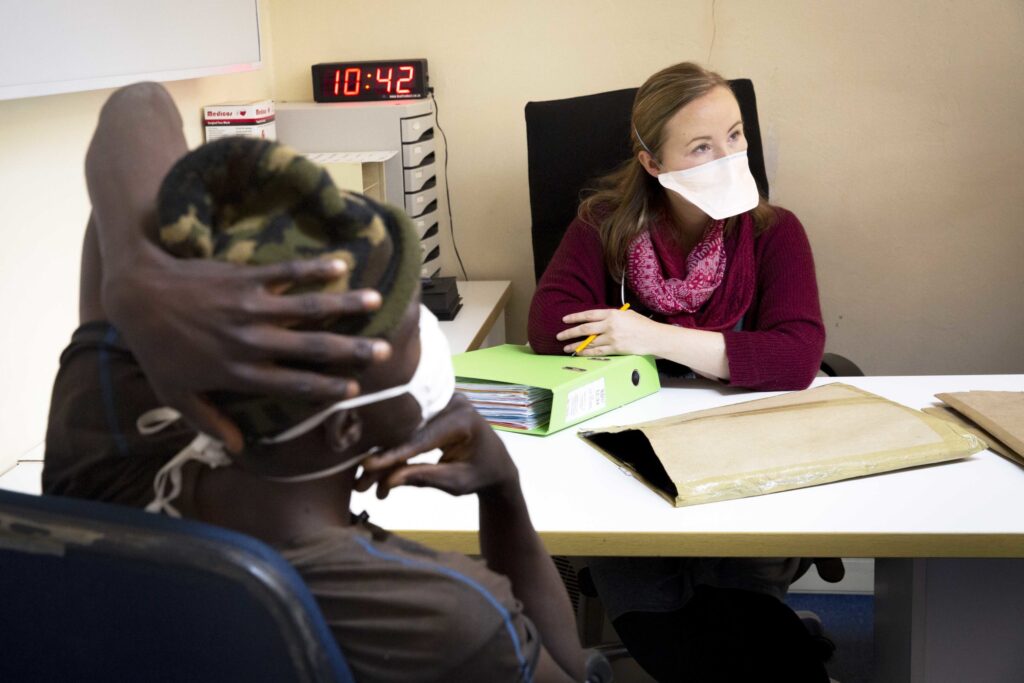- No other disease in South Africa kills as many people as tuberculosis (TB). To change this, the health department has a new plan for curbing TB infections.
- Until now, only people with HIV and children under five could get preventive medicines. But the new guidelines say anyone who has a big chance of getting infected because they are in contact with someone who has TB, can get the pills.
- Preventive treatment can help to stop infections from spreading, but it needs to be part of a bigger strategy if it is to really get us closer to ending TB.
In 2005, when Busisiwe Beko suspected that she was pregnant, she headed to her local clinic for a test. Beko got more than she bargained for: she tested positive for HIV too.
Every day, Beko took a taxi or bus to the restaurant where she worked. Even though she lived by herself, she was surrounded by other people for long periods a day.
A few months into her pregnancy, she started sweating at night and coughing.
She went back to the clinic and was diagnosed with tuberculosis (TB).
TB spreads through the air, so she could have picked it up from anyone she had contact with at her job or during her commute. When someone with TB in their lungs coughs, sneezes, sings or talks, they release TB bacteria into the air, which others close by can inhale.
At the time, South Africa had 1 210 TB cases for every 100 000 people, one of the highest infection rates in the world. That’s more than double the number of cases the country reported in 2021. Almost 74 000 people died of TB in 2005.
Being HIV positive meant Beko had a big chance of falling ill with TB, as the virus weakens your immune system and so makes it hard to fight off TB germs.
[LISTEN] Is this the new TB patient? About half of infected people don’t have symptoms
Almost 20 years on, the approach to dealing with TB infections has changed significantly. Instead of having to wait to test positive, people with a big chance of getting TB (such as those with HIV) have, since 2011, been able to swallow a pill once a day for six months to prevent infection. The tablet contains isoniazid, an antibiotic that kills TB germs.
Despite TB infections having steadily come down since 2015, South Africa still has one of the highest rates of TB in the world. Over 300 000 South Africans had TB in 2021 and about 56 000 people had died from the disease in that year.
In February, the health department published a new set of guidelines to tackle infections. But will it work to get us closer to ending TB?
Old disease, new plan
Up to now, the health department gave preventive medicines only to people with HIV and children under five, as they are the most likely groups to develop TB when they are in close contact with someone who has the disease. Because their immune systems might not be strong enough, these groups have a bigger chance of dying from TB.
But with the new guidelines, everyone who has had “significant exposure” to TB can now get treatment, regardless of HIV status or age, and there are four different treatment options.
One is a three-month course of two antibiotics (isoniazid and rifapentine) taken only once a week, instead of one pill every day for six months (this treatment is called 3HP for short). As a rule, say the guidelines, “shorter treatment options should be offered where feasible and available”, as patients are more likely to complete the course and taking medicine for a shorter period is easier on someone’s body.
Significant exposure means being in the same space as a person with TB for one or more nights or for long periods during the day. It doesn’t matter whether the contact is at home, where someone works or at school.
Someone who has a big chance of getting infected because they are exposed to TB must, however, test negative for TB disease. This means you must either not have any TB germs in your body at all or the infection must be latent.
With a latent infection you may have TB bacteria in your body but you won’t show any symptoms of the disease, which means your immune system is able to fight the infection well enough so that you can’t spread the germs to someone else.
Active TB (TB disease), though, develops when the immune system can no longer fight the germs in an infected person’s body well, and so they start to show symptoms of being sick and become contagious. Once someone has developed active TB, they need a different course of treatment, and so the medication given to people for preventing infection will simply not help such patients.
Why prevention is better than cure
Despite TB being preventable and treatable, it’s the top cause of people dying from disease in South Africa. But because government resources to find, diagnose and treat TB cases are not enough and healthcare staff often don’t follow the right steps to look for TB symptoms, many cases go undiagnosed. This makes it harder to control the spread of the disease, and so more people end up getting sick or dying — unnecessarily.
Research also shows that the aftermath of TB continues long after someone is cured, with many people having health problems such as a lasting cough or being short of breath all the time.
But preventive pills don’t protect you forever — nor are they enough on their own.
A large study, run from 2006 to 2011 among gold miners, a group of people among whom there were about 7 000 cases per 100 000 in 2005, showed that although the treatment stopped these workers from getting TB, the effects did not last very long. Unlike with a vaccine, the protective effect disappears shortly after you stop taking the medicine. Moreover, just handing out pills won’t be enough to curb infections, this study showed — it has to be part of a bigger strategy in which TB cases are spotted better, treatment starts early and antiretrovirals against HIV are widely available.
Is a better plan worth the spend?
A 2020 study by the IMPAACT4TB Consortium — a project put together by a group of health research organisations including The Aurum Institute and John Hopkins University — showed that through their project alone, more than 14 000 cases of active TB and close to 1 600 deaths could be prevented over 10 years with an up-front investment of $52.5-million. Moreover, their prediction showed that investing in preventive treatment now delivers much bigger benefits later, as it could help countries improve their roll-out of these medicines and so avert over 375 000 further cases and more than 41 000 extra deaths.

Foster Mohale, spokesperson for the department of health, says that funding for the new preventive plan will be clarified once contracts are in place for the two drugs of the 3HP course to be supplied to state clinics. This is why the prevention therapy has not yet been rolled out widely, he says.
Mohale explains that, in general, services to diagnose and treat TB are funded by the National Treasury through equitable share and conditional grants. With equitable share funds, which are calculated based on how many people there are in a province, rulemakers have some freedom to decide on which services to spend their funds. Money given to them as a conditional grant has to be spent as prescribed by the national government.
Donor organisations such as the Global Fund and the United States President’s Emergency Fund for Aids Relief, Pepfar, also pitch in to help cover the costs.
Pills and prevention
The World Health Organisation’s “End TB” strategy says governments should offer drugs that can prevent TB to people who are most likely to develop the disease. Studies from Ethiopia, Tanzania and Côte d’Ivoire show that if people finish a six- to twelve-month course of antibiotics, fewer new infections occur.
But in South Africa, before the new guidelines were published, few people who could get the prevention pills actually did. According to health department data, around 270 000 HIV-positive patients on antiretroviral therapy started taking preventive TB medicine in 2022. (To put this in perspective, 5.7-million people with HIV were taking antiretrovirals in 2022.)

But the slow uptake in South Africa is not different from what happens elsewhere. A survey across 35 countries found that although 33 of these governments had written preventive therapy into their TB guidelines, only about two-thirds could supply people with steady treatment. Many countries experience stock-outs of isoniazid and often programme managers do not coordinate HIV and TB projects well.
In a study across 31 clinics in three of South Africa’s provinces with many TB infections (the Eastern Cape, KwaZulu-Natal and the Western Cape), researchers found that even in areas where TB health services worked well, not enough was done to track patients on preventive drugs, so healthcare workers had no way of knowing whether patients actually finished their treatment.
In the Eastern Cape and KwaZulu-Natal, there were often isoniazid shortages, and although clinics in the Western Cape had enough of the medicine, there were often not enough tests to check for TB infection, staff said. However, this should not have been an issue, as someone doesn’t have to be tested for TB infection to get the prevention pills, only for active disease.
Moreover, many healthcare workers seem sceptical about whether preventive treatment really works and so weren’t keen to hand out the pills. Indeed, a study from Tshwane found that health workers need more training, especially to identify children who can benefit from taking medicines to prevent their chance of contracting TB.
With the new guidelines in place, perhaps an experience like Beko’s from almost 20 years ago can be avoided.
Says Beko: “When my daughter was five months old, she too was diagnosed with [multidrug-resistant] TB. The treatment was hard on her. There were times when she was like a zombie.”
Nicole Ludolph is a health journalist at Bhekisisa.







